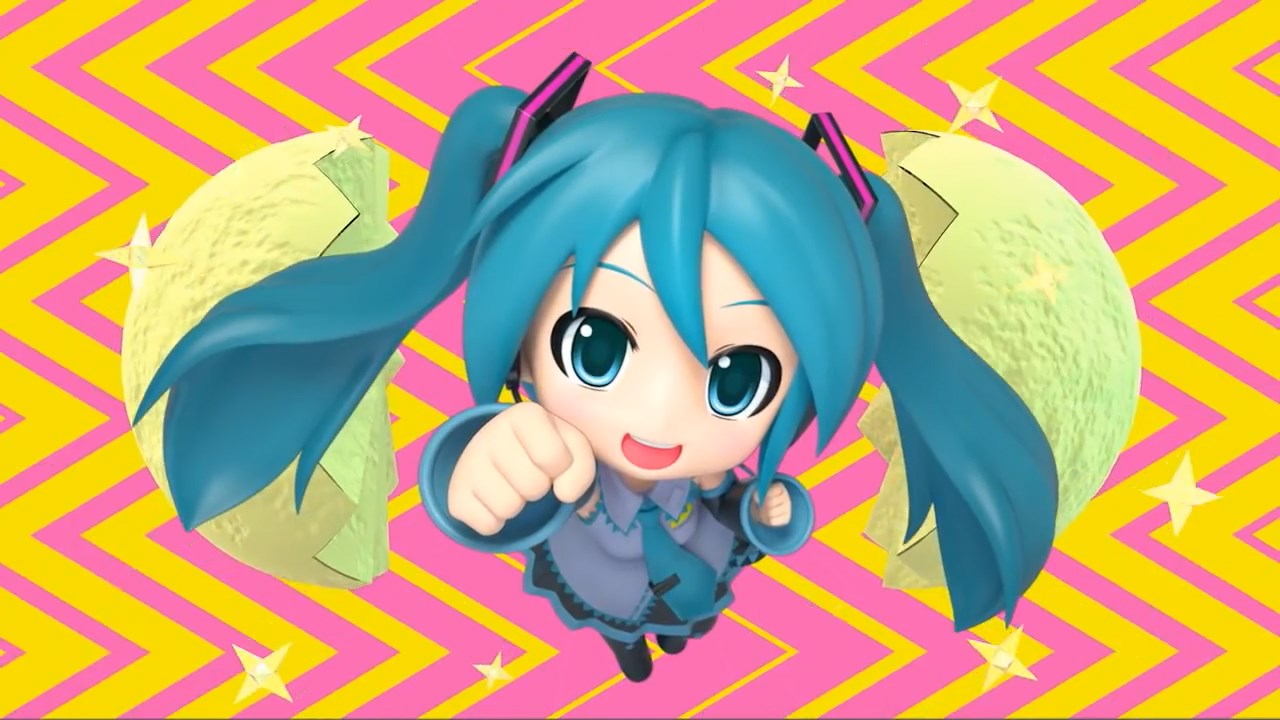After reviewing Project DIVA F 2nd earlier, here’s my review of Project Mirai DX on the 3DS. While Project Mirai DX is also a rhythm game in the same vein as the Project DIVA series, the games are actually not all that similar. While the Project DIVA F games are aimed at a more mature audience and feature a rather high difficulty level, Project Mirai DX is notably easier and more accessible for newcomers to rhythm games. And while Project DIVA F at times featured somewhat risqué costumes, music videos and artwork (though nothing particularly scandalous, as evidenced the T rating by the ESRB), Project Mirai DX keeps things very family-friendly. The chibi design SEGA used for the characters is absurdly cute, and the tone is consistently upbeat and lighthearted.
Rhythm game?
While at its core Project Mirai DX is most definitely a rhythm game, the way the game starts would make it seem otherwise. You’re first asked to choose one of the Vocaloids as your partner and a room for him/her to live in. The choice isn’t all that important though, as you can switch to a different character or room at any time. The character you’ve chosen will then walk around the room and interact with the various items that you can place there. These items can be bought using Game Coins earned in the main rhythm game. For example, if you place a running mill in the room you might see the character attempt to use it, with sometimes amusing results. This mode is similar to the DIVA room in Project DIVA F, but perhaps surprisingly, it’s actually a bit more elaborate. More on that later, but first let’s move on to the main part of the game, the actual rhythm game!
Gameplay
Project Mirai DX takes a different approach to the gameplay seen in Project DIVA games. In the Project DIVA games, the button prompts can appear from any direction at the side of the screen. In Project Mirai, the button prompts always appear on a single linear line that is drawn across the screen as the music plays in the background. That said, the way the line is drawn varies per song.
The game offers two different control schemes: Tap and Button mode. You can either use the touch controls on the bottom screen of the 3DS, or the standard face buttons and directional input. The way the game is played also differs depending on which one you choose. Depending on the difficulty you’re playing, Tap mode uses up to three different panels that you need to tap, while Button mode uses up to four buttons combined with the four directional inputs. Personally, I preferred the standard face buttons over touch screen input, and I imagine those used to playing Project DIVA are likely to prefer this method as well. Both methods are entirely viable however, so it’s really up to personal preference.
In both modes, special button prompts may appear from time to time. A thick line may appear between two button prompts, which means you’ll have to press (or tap) the respective button/panel and hold it until you reach the next prompt. If the line is rainbow colored, you’ll also have to swirl the panel or Circle pad. In button mode, dual lines may also appear, requiring you to press both a directional button and a face button at the same time. In Tab mode, arrow markers require you tab and slide in the direction of the arrow.
Like in Project DIVA, you can also use helper items that can be purchased with Game Coins to make it easier (or more difficult) to complete a song.
Graphics, Presentation and Audio
Graphically, the game makes a good impression. The menu’s and music videos all use vibrant and bright colors. and the 3D characters are detailed enough to show off their wide array of expressions. The game also allows you to customize the in-game interface to a high degree. You can toggle display options to change various elements of the HUD, for example the icon size, panel order and how much information is shown on the screen.
I expected the presentation of the music videos that accompany each song to be a lot less impressive than Project DIVA, given the limitations of the 3DS hardware. While this was true to some extent, I was surprised to find that it’s not always the case. For example, the song Kokoro had a rather limited presentation in Project DIVA F, and I found that the video in the 3DS version was actually better. Not only was it more varied, but it also better explained what the song was actually about.
Unique to Project Mirai is the possibility to swap the characters and vocals for some of the songs. This not only allows you to use different characters for the songs’ music video, but (unlike Project DIVA games) the songs will also be sung in that character’s voice. While only a limited number of songs allow this, and certain requirements have to be met to unlock it, this is certainly an interesting addition to the game.
Of course, a rhythm game needs to have good audio quality, and the game doesn’t disappoint there. However, I definitely recommend using a headset instead of the standard speakers on the 3DS. It not only makes a big difference in audio quality but also helps keeping in sync with the rhythm.
Something I do find disappointing is the lack of English lyrics for the songs in the game. All but one of the songs featured in Project DIVA F 2nd offered an English translation for the lyrics, so it’s unfortunate that these are absent from Project Mirai DX. There’s plenty of songs that tell an actual story, like Kokoro, and not having the lyrics makes it more difficult for the player to understand what’s actually going on. Project Mirai DX also has the potential to aim at a demographic that is less familiar with Hatsune Miku and Vocaloids, and for those people understanding the lyrics would be even more important. After all, those familiar with the series are far more likely to already know the songs.
All in all, it’s not a major issue, but I think it does prevent the game from reaching its full potential in the West.
Additional Content
In “Hang out mode”, you can interact with your character, for example giving them snacks and drinks you bought. You can also give them allowance. They’ll buy anything ranging from food to actual costumes (which you can then use in the rhythm game), and you can see a record of all their purchases to know what they’re spending their money on.
Aside from that, you can also head into town with your character and visit various locations. This includes the Mirai Mall, where you can buy items and furniture for your room and outfits for your character (over 110 in total). Mirai Theater allows you to view the game’s music videos outside of the rhythm game (interestingly, pressing buttons during the music video allows you to make some noise, such as applause). Additionally, you can make your own playlists here. Visit Mirai Estates to buy new room types, or even book a vacation to Mirai Resort for your character. Once you do, the airport will appear on the map to take you overseas to your new location.
Dance Studio allows you to build your own dance routine. You decide the song your character will dance to and all the moves your character will make during the song. There’s a Simple and Advanced mode, depending on how much control you want over the dance. Once complete, you can watch your character perform the dance from different camera angles.While this mode may not be for everyone, and I personally spent most of my time in the actual rhythm game, this is a nice addition to the game that can really be a time-sink for people who enjoy it.
The other mini-game is Mikuversi, a Miku variant of Reversi. You can challenge your partner to a game of Mikuversi, and they’ll learn to play better as you play more matches with them. Personally, I much preferred Puyo Puyo!
As you can tell, there’s a ton of content in this game, even aside from the main rhythm game. Seeing everything this game has to offer would require you to invest a lot of time!
Verdict
It also features a ton of side content on top of the main rhythm game. If you enjoy the simulation aspect of the game, you can quite easily spend more time there than on the main rhythm game. But even if you don’t, the rhythm game alone is well worth the price of admission!

